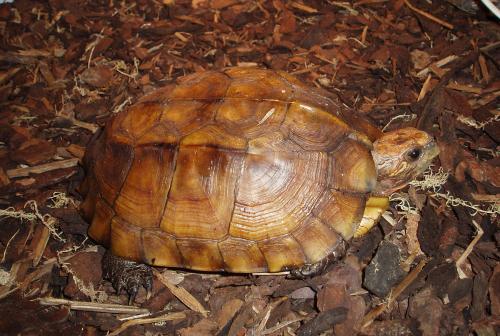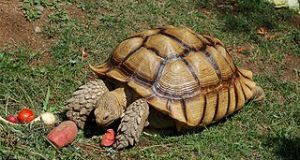Turtle enthusiasts are, in my experience, among the most intense of all reptile keepers. Passionate (and financially well-off!) friends of mine have maintained astonishing collections – upwards of 2,000 specimens in several cases – and their desire to learn remains undiminished. In recent years, refined breeding techniques have introduced and re-introduced many fascinating species to the pet trade. Today I’d like to cover several that might interest folks with varying degrees of experience. I’ll review others in the future…until then, please post notes about your own favorites (“new” or “old”) below, as those mentioned here are just a small sample.
Peacock Slider, Trachemys scripta venusta
Also known as the Meso-American Slider, this aptly-named beauty truly is the “peacock” of its family, and one of the most spectacularly-colored of all American turtles. Hatchlings must be seen to be believed (unfortunately, the only photo I was able to use does not do the species justice; please click here for other photos), and they fade but little with age. The numerous dark-centered, orange-ringed spots that decorate the olive to bright green carapace are unique in the turtle world, and they are off set nicely by the yellow-striped head and legs.
The Peacock Slider’s range extends from southern Mexico (Veracruz) through Guatemala and Belize to El Salvador and Honduras. Within much of this area, it can be quite common…image having this as your local “pond turtle”! Like its cousin the Red Eared Slider, the Peacock spends much time basking on logs, plunging (or “sliding”) into water when disturbed.
Unfortunately for those with limited space, this is the largest of the 15 Common Slider subspecies, with females sometimes topping 19 inches in length. Otherwise, it is quite hardy and may be kept and fed as are Red Eared and other sliders (please see the article linked below for detailed information). A male (the smaller sex) might get by in a 55-75 gallon aquarium, but females need tanks of 100 gallon capacity, or commercial turtle tubs and ponds.
Keeled Box Turtle, Cuora (Pyxidea) mouhotii
This subtly-beautiful turtle has been largely ignored by hobbyists and zoos alike, but it is now gaining in popularity.
Also known as the Jagged-Shelled or Indian Thorn Turtle, it bears a unique carapace which is flattened on top and decorated with 3 distinctive keels. The shell is clad in varying shades of brown, tan and rust, and is serrated at the rear edge. A hinge in the plastron of the adults allows the head and front limbs to be sealed tightly into the shell. They top out at 7 inches in length.
The Keeled Box Turtle ranges from southern China and eastern India through Vietnam, Thailand and Myanmar. It is not well-studied in the wild, but seems to be restricted to forests and other habitats with thick plant cover.
Interestingly, they are reported to be largely nocturnal. However, a 30+ year-old pair under my care were content to forage by day. Night viewing bulbs will help you observe those that may be slow to give up their nocturnal ways.
Their care follows that of most American Box Turtles (Terrepene spp.), but in demeanor they are much shyer. Mine thrived on a diet comprised of vegetables, fruits, crickets, earthworms, pink mice and commercial turtle chows such as Zoo Med Box Turtle Food.
Pairs must be watched closely, as males often bite females during courtship. A typical clutch contains 1-5 eggs, which hatch after an incubation period of 95-110 days at 82 F. Please see the article linked below for further information.
The Yellow-Spotted Sideneck Turtle, Podocnemis unifilis,
This attractive South American turtle commonly appeared in the US trade in the 1960’s and 1970’s. Scarce in the decades since, it is now making a comeback. It sports a yellow-rimmed, olive-gray carapace, with large, bright yellow or orange-yellow spots decorating the head.
The Yellow Spotted Sideneck inhabits northern and central South America, from Guyana, French Guiana and Venezuela to Columbia, Ecuador, northeastern Peru, northern Bolivia and Brazil; it may also be present on Trinidad and Tobago.
An active, semi-aquatic turtle that reaches 12-18 inches in length, the Yellow-Spotted Sideneck is best kept by those with room for a 100+ gallon aquarium or a commercial turtle tub or pond. Dry basking areas and ample UVB exposure are essential. Youngsters are largely carnivorous, adding plants to the menu as they mature. Zoo Med Aquatic Turtle Food,specifically formulated for Sidenecks and similar turtles, may be used as a cornerstone of the diet. Please see the article linked below for additional information on the natural history and care of this spectacular turtle
Further Reading
Yellow Spotted Sideneck Turtle Care
Slider, Map and Painted Turtle Care
 That Reptile Blog – Reptile, Amphibian and Exotic Pet Care and Information
That Reptile Blog – Reptile, Amphibian and Exotic Pet Care and Information





